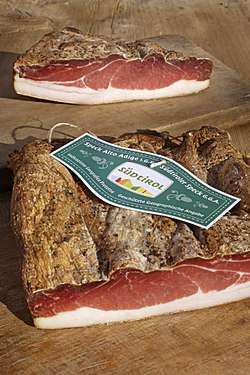List of hams

This is a list of notable hams and ham products. Ham is pork that has been preserved through salting, smoking, or wet curing.[1] It was traditionally made only from the hind leg of swine, and referred to that specific cut of pork.[2] Ham is made around the world, including a number of highly coveted regional specialties, such as Westphalian ham and Jamón serrano.
Technically a processed meat, "ham" may refer to a product which has been through mechanical re-forming. The precise nature of meat termed "ham" is controlled in a number of areas, often by statute, including the United States and European Union. In addition, numerous ham products have specific geographical indication protection, such as Prosciutto di Parma and Prosciutto Toscano PDO in Europe, and Smithfield ham in the United States.
Hams and ham products
Bulgaria
- Elenski but – a dry-cured ham from the town of Elena in northern Bulgaria and a popular delicacy throughout the country.[3][4] The meat has a specific taste and can be preserved in the course of several years, owing much to the special process of making and the climatic conditions of the part of Stara Planina where Elena is located.
China
- Anfu ham – an ancient dry-cured ham from Anfu, Jiangxi, China that originated from the Qin Dynasty.[5] It is eaten alone and also used as an ingredient to add flavor to various dishes.[5]
- Jinhua ham – a type of dry-cured ham named after the city of Jinhua, where it is produced, in the Zhejiang province of eastern China.[5] The ham is used in Chinese cuisines to flavor stewed and braised foods as well as for making the stocks and broths of many Chinese soups.[4] It is prepared using the Tongcheng pig and has been described as "the most prized ham in all of China".[4]
- Rugao ham – a dry-cured ham that originated in Jiangsu province, China, and was first prepared in 1851.[5][6] Rugao ham is named after Rugao in Jiangsu province and is produced in a diverse variety of flavors, colors and weights.[5][7]
- Xuanwei ham – a local dish in the Qujing prefecture in Yunnan province, China.[5][8] Xuanwei ham has a 250-year history dating back to 1766. In 1909 it was first mass-produced and gained popularity. It is also used as an ingredient in various dishes.[5]
Czech Republic
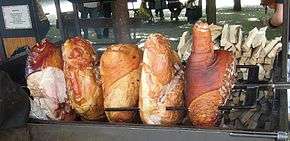
- Prague Ham – brine-cured, stewed, and mildly beechwood-smoked boneless ham[9][10][4] originally from Prague in Bohemia (Czech Republic).
England
- York Ham – a historical ham from Yorkshire, England, it is a mild-flavoured ham with delicate pink coloring.[4] York Ham is traditionally served with Madeira Sauce.[11][12] As a lightly smoked, dry-cured ham, York ham is saltier but milder in flavour than other European dry-cured hams.[13] Folklore has it that the oak construction for York Minster provided the sawdust for smoking the ham. Robert Burrow Atkinson's butchery shop, in Blossom Street, is the birthplace of the original "York Ham" and the reason why the premises became famous.[14]
France
- Bayonne ham – a cured ham that takes its name from the ancient port city of Bayonne in the far South West of France, a city located in both the cultural regions of Basque Country and Gascony.[3][4] Jambon de Bayonne has protected geographical indication (PGI) status.
Germany

- Ammerländer Schinken – a dry-cured (and normally smoked) ham produced in the Ammerland area of North Germany. It has PGI status under European Union law.[4]
- Black Forest ham – a variety of dry-cured smoked ham, produced in the Black Forest region of Germany[3][4]
- Westphalian ham – produced from acorn-fed pigs raised in the forests of Westphalia, Germany,[15][16] the resulting meat is dry cured and then smoked over a mixture of beechwood and juniper branches.[15][17][18][16][4]
Ireland
- Limerick ham – method of preparing a joint of ham within the cuisine of Ireland. The method was originally developed in County Limerick, Ireland.
Italy
- Culatello – similar to prosciutto but is made from the filet or loin of the hind leg, it originated in Parma, Italy.[3]
- Prosciutto – an Italian dry-cured ham that is usually thinly sliced and served uncooked; this style is called prosciutto crudo in Italian (or simply crudo).
- crudo di Cuneo PDO (Piedmont)
- prosciutto di Carpegna PDO (Marche)
- prosciutto di Modena PDO (Emilia-Romagna)
- prosciutto di Parma PDO (Emilia-Romagna)
- prosciutto di San Daniele PDO (Friuli-Venezia Giulia)
- prosciutto toscano PDO (Tuscany)
- prosciutto Veneto Berico-Euganeo PDO (Veneto)
- prosciutto amatriciano PGI (Lazio)
- prosciutto di Norcia PGI (Umbria)
- prosciutto di Sauris PGI (Friuli-Venezia Giulia)
- Speck Alto Adige PGI – a dry-cured, lightly smoked ham (prosciutto in Italian), produced in South Tyrol, northern Italy. Parts of its production are regulated by the European Union under the PGI status. In Italy and Turkey parts of the English-speaking culinary world, the term "speck" refers to Italian Speck Alto Adige PGI, a type of prosciutto.[19]
- Tyrolean Speck – a distinctively juniper-flavored, de-boned ham originally from Tyrol, an historical region that since 1918 partially lies in Italy.[4] The first historical mention of Tyrolean Speck' was in the early 13th century when some of the current production techniques were already in use.
- Vallée d’Aoste Jambon de Bosses – a spicy, cured ham product from Saint-Rhémy-en-Bosses in the Aosta Valley in Italy,[20] one of the region's specialties.[21][22] It was awarded protected designation of origin (PDO) status by the European Union.[23]
Luxembourg
- Éisleker Ham – literally "Oesling ham", is a speciality from the Oesling region in the north of Luxembourg which is produced from the hind legs of pigs. Traditionally, it was prepared by marinating the hams in herbs and vinegar for several days, then hanging them in a chimney for long periods of cold smoking. Today the meat is cured in brine for two weeks and placed in a smoker fed from beech and oak chips for about a week.
Montenegro
.jpg)
- Njeguški pršut – a dry-cured ham served uncooked, similar to Italian Prosciutto, it is a specialty of Njeguši, a village in Montenegro
Portugal
- Jamón ibérico – produced in Spain and Portugal
- Presunto – a dry-cured ham from Portugal, similar to Spanish jamón or Italian prosciutto crudo.
Spain
.jpg)
- Jamón – the Spanish word for "ham", in English it refers to certain types of dry-cured ham from Spain.
- Jamón de Guijuelo – has PDO status
- Jamón de Huelva – has PDO status
- Jamón de Teruel – has PDO status
- Jamón de Trevélez – has PDO status
- Jamón Dehesa de Extremadura – has PDO status
- Jamón ibérico – produced in Spain and Portugal, according to Spain's Denominación de Origen rules on food products, it may be made from black Iberian pigs, or cross-bred pigs so long as they are at least 50% ibérico[3][4] It is required to be aged for a minimum of three years.[4]
- Jamón serrano – a dry-cured ham that has traditional specialities guaranteed (TSG) status.[4]
- Lacón Gallego – is a dried ham product from Galicia, Spain with PGI status under European law
United States

- Chipped chopped ham – a processed ham luncheon meat made from chopped ham. Chopped ham is a mixture of ham chunks and trimmings and seasonings, ground together and then packaged into loaves.
- City ham - a variety of brine-cured ham which is only partially cured and must be refrigerated for safe storage. Known simply as "ham" in regions of the U.S. where country ham is unknown.
- Country ham – a variety of dry-cured ham, referring to a method of curing and smoking done in the parts of the Southeast U.S. states of North Carolina, South Carolina, Tennessee, Virginia, Georgia, Kentucky, Missouri, and other nearby states.[4]
- Glazed ham – glazed ham in the U.S. is coated with a flavored or spiced sugar solution before cooking. Glazed gammon is a glazed pork dish that is technically not ham, as it is the hind leg of pork after it has been cured by dry-salting or brining. Gammon differs from ham in that ham is cured after being cut from the carcass and sold cooked, and the curing process for ham may be different.
- Smithfield ham – a specific form of country ham finish-cured in the town of Smithfield in Isle of Wight County in the Hampton Roads region of Virginia, United States.[4]
- Hams and ham products

 Honey glazed ham
Honey glazed ham Sliced jamón ibérico
Sliced jamón ibérico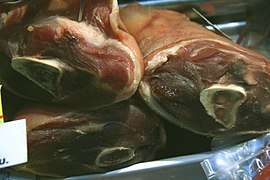
 Njeguški pršut being cured with smoke
Njeguški pršut being cured with smoke- Prosciutto in a smokehouse
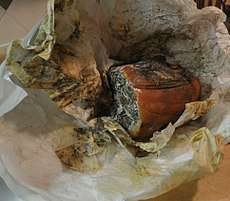 Smithfield ham in its wrapping
Smithfield ham in its wrapping Sliced Speck Alto Adige PGI
Sliced Speck Alto Adige PGI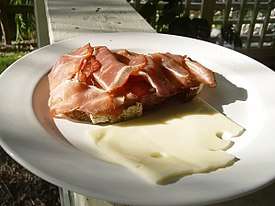 Westphalian ham atop bread, with cheese
Westphalian ham atop bread, with cheeseXuanwei_ham.jpg) Xuanwei ham in a butcher shop
Xuanwei ham in a butcher shop
See also
- Ham hock
- Ham sausage
- List of dried foods
- List of ham dishes
- List of pork dishes
- List of smoked foods
- Turkey ham – a processed food made primarily from cooked or cured turkey meat and water, formed into the shape of a ham and often sold pre-sliced.
References
- ↑ "Red and processed meats and cancer prevention". World Cancer Research Fund.
- ↑ "Bacon: Bacon and Ham Curing" in Chambers's Encyclopædia. London: George Newnes, 1961, Vol. 2, p. 39.
- 1 2 3 4 5 DK Publishing (2010). The Illustrated Cook's Book of Ingredients. The Illustrated Cook's Book of Ingredients. Penguin. p. 164. ISBN 978-0-7566-7673-5.
- 1 2 3 4 5 6 7 8 9 10 11 12 13 14 15 Nosowitz, Dan (December 24, 2016). "Check Out These Sick Hams From Around The World". Modern Farmer. Retrieved May 22, 2017.
- 1 2 3 4 5 6 7 Isacs, John H. (January 16, 2014). "How to match dry-cured swine with perfect wine". Shanghai Daily. Retrieved 21 May 2017.
- ↑ Hui, Y.H.; Evranuz, E. Özgül (2016). Handbook of Animal-Based Fermented Food and Beverage Technology, Second Edition. CRCNET books. CRC Press. pp. 656–657. ISBN 978-1-4398-5023-7. Retrieved May 22, 2017.
- ↑ Ang, C.Y.W.; Liu, K.; Huang, Y.W. (1999). Asian Foods: Science and Technology. Taylor & Francis. p. 209. ISBN 978-1-56676-736-1. Retrieved May 22, 2017.
- ↑ "Xuanwei ham". kaleidoscope.cultural-china.com. Retrieved 2016-06-28.
- ↑ Prague Ham
- ↑ About Prague Ham - and Czech Beer
- ↑ "Home Cooking – Ham Varieties and Terminology". About.com. The New York Times Company. 16 September 2008. Retrieved 5 October 2008.
- ↑ "Recipe Favourites York ham and other recipes related to York ham". Recipe Tips. Retrieved 5 October 2008.
- ↑ Alden, Lori. "Cook's Thesaurus: Ham". Food Subs. Retrieved 5 October 2008.
- ↑ "History of 57 & 59 Blossom Street". Oliver's of the Mount. Archived from the original on 29 June 2012. Retrieved 5 October 2008.
- 1 2 Hayes, Kevin J. (2008). The Road to Monticello: The Life and Mind of Thomas Jefferson. Oxford University Press. p. 363. ISBN 0199758484.
- 1 2 The Encyclopedia of Healing Foods - Michael T. Murray, Joseph E. Pizzorno. p. 616.
- ↑ Daily Consular and Trade Reports. Department of Commerce and Labor, Bureau of Manufactures (U.S.). 1912. p. 55.
- ↑ Swindled: The Dark History of Food Fraud, from Poisoned Candy to Counterfeit ... - Bee Wilson. p. 11.
- ↑ Speck - Smoked Prosciutto (Mario Batali)-Dead link- Archived 2007-11-02 at the Wayback Machine.
- ↑ Touring Club of Italy (2004). The Italian Wine Guide: The Definitive Guide to Touring, Sourcing, and Tasting. Touring Editore. p. 30. ISBN 978-88-365-3085-4.
- ↑ Labourdette, Jean-Paul; Auzias, Dominique. Milan / Turin 2010 Petit Futé. Petit Futé. p. 268. ISBN 978-2-7469-2857-2.
- ↑ "Gusto Raro: Jambon de Bosses DOP - Italian typical ham". Retrieved 2 September 2011.
- ↑ Anderson, Burton. The Foods of Italy (5 ed.). Italian Trade Commission. pp. 127–29. ISBN 978-1-4507-5291-6.
External links

